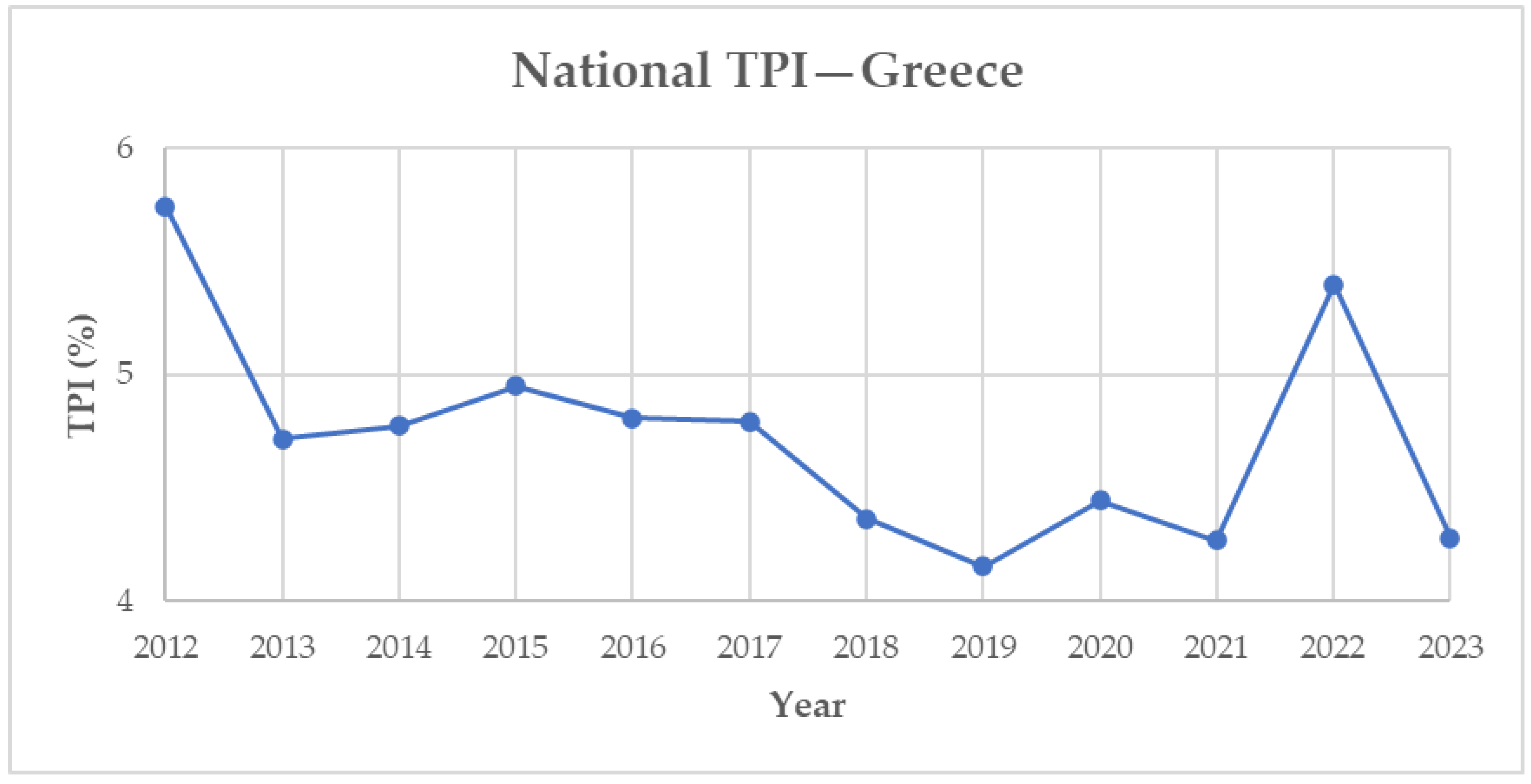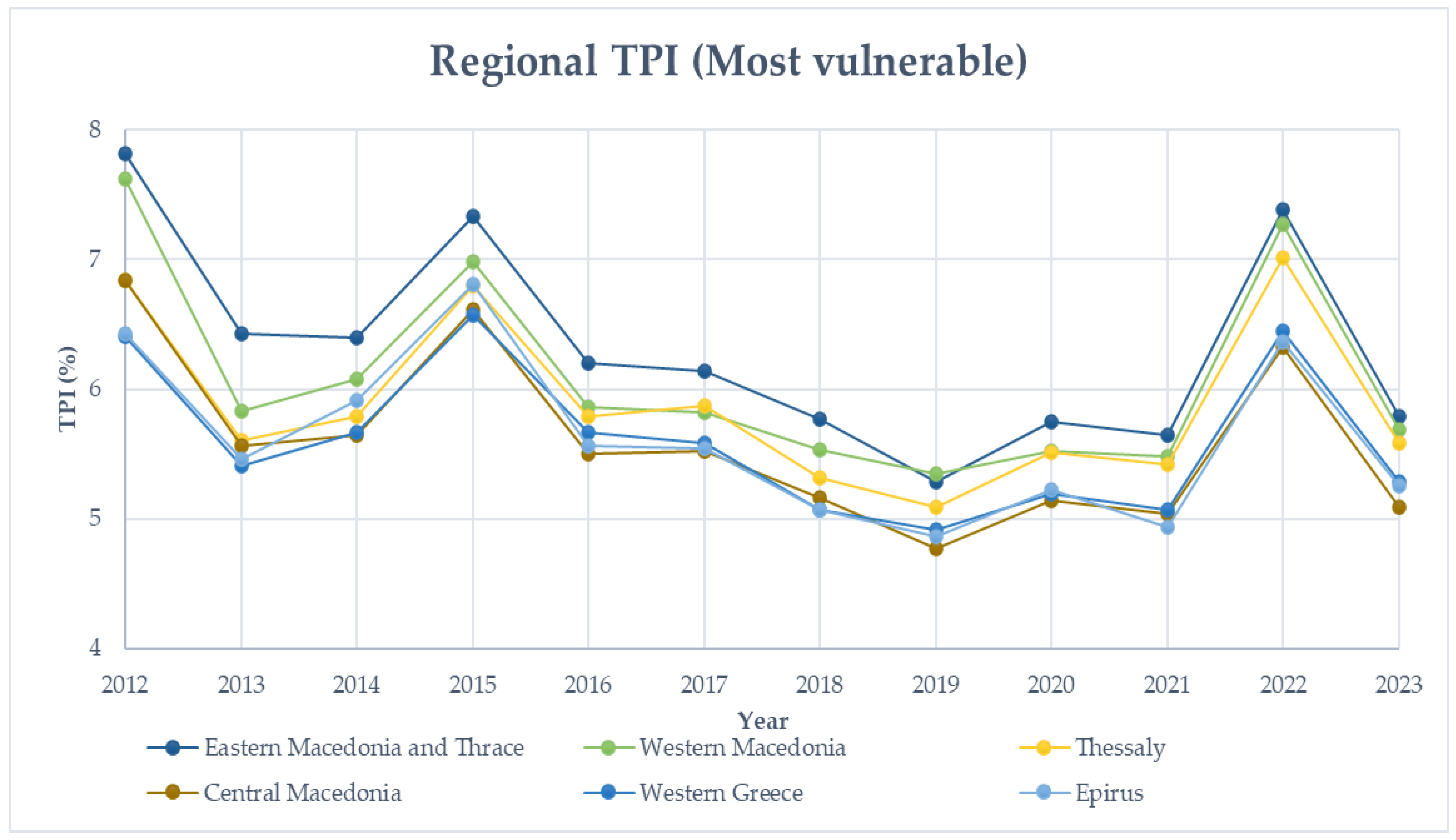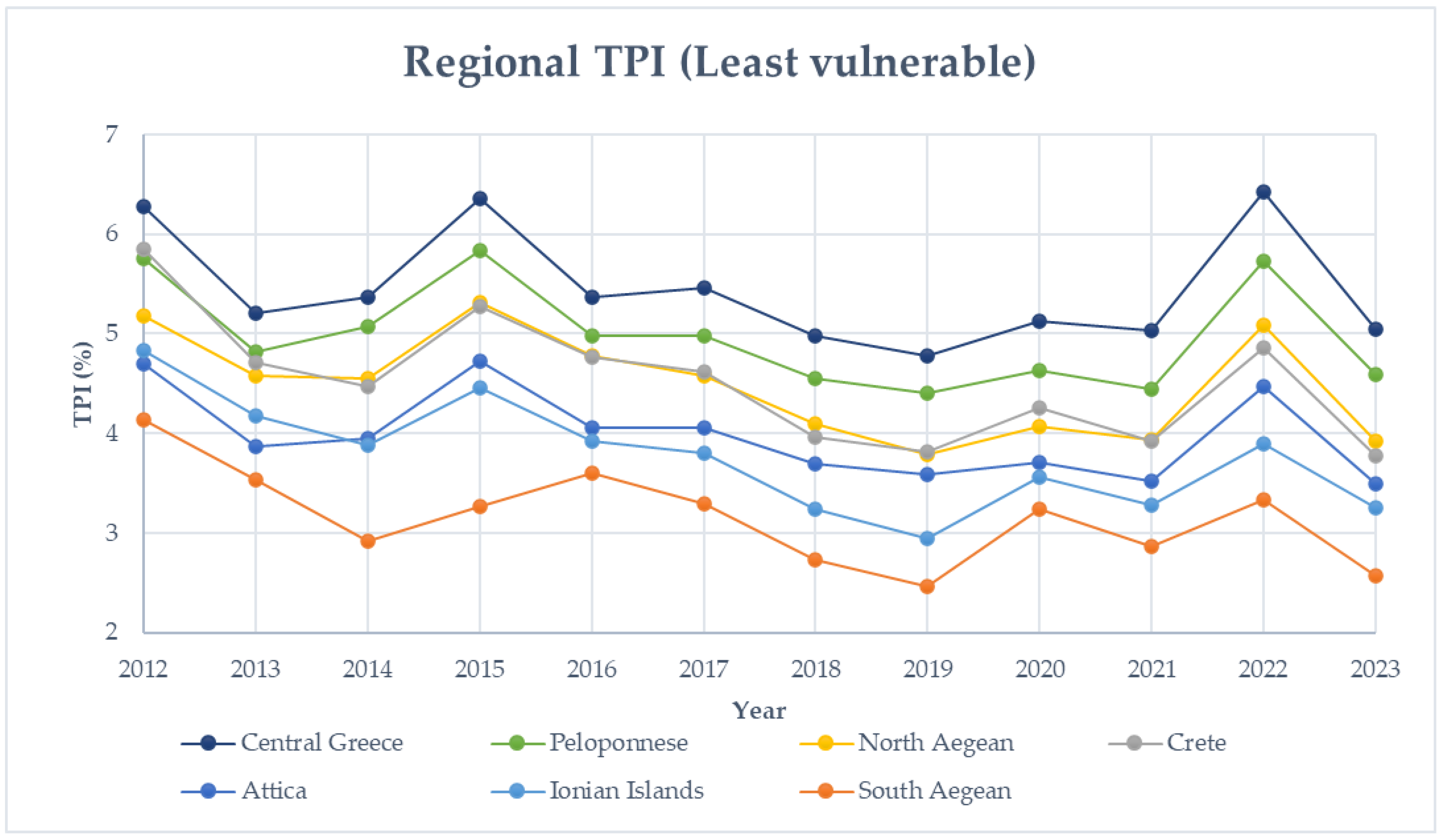Assessing Energy Poverty in Greece Using Open-Access Data: A National and Regional Analysis Based on the 10% Indicator
Abstract
1. Introduction
2. International and EU Initiatives to Tackle Energy Poverty
3. Materials and Methods
3.1. Energy Poverty Indicators
- 10% Indicator (TPI): A household is considered energy-poor if it spends more than 10% of its income on energy.
- 2M: Households spending more than twice the national median energy expenditure-to-income ratio are classified as energy-poor.
- M/2: A household is identified as potentially energy-poor if the share of its energy spending relative to its income is less than half the national median.
- Low Income, High Cost (LIHC): A household is energy-poor if it has higher-than-median energy costs and its residual income falls below the poverty line.
- Minimum Income Standard (MIS): A household is classified as energy-poor if, after covering its energy expenses, its remaining income falls below the minimum income threshold required for a decent standard of living.
- Inability to keep home adequately warm: Self-reported inability to maintain adequate thermal comfort in winter.
- Arrears on utility bills: Households reporting difficulty or inability to pay electricity, gas, or heating bills on time.
- Severe arrears: The household reports having postponed the payment of utility bills on multiple occasions.
- Compound Energy Poverty Indicator (CEPI): It is a composite indicator that includes elements such as whether the house is hot/cold/dark, whether there are leaks and arrears on bills [48].
- Energy Poverty Vulnerability Index (EPVI): This index combines socio-economic indicators of the population with building’s characteristics and energy performance [49].
3.2. Methodological Framework
- s stands for the energy source.
- stands for the household energy consumption by energy source i, for each year;
- stands for the price per unit of energy source i, for each year;
- stands for the household income, for the year t;
- stands for the energy source used for household energy needs; i = [electricity, natural gas, heating oil, firewood];
- stands for the reference year of the calculation; t = [2012, 2023].
- The annual national energy prices for the four energy sources were also adopted as the reference prices for all regions.
- The annual regional electricity consumption was allocated using a simple proportional method, based on the ratio of regional to national population (latest census [62]). The applied formula is shown in Equation (3):where
- stands for the national household electricity consumption, for the year t;
- stands for the population of region r;
- stands for the national population of Greece;
- r stands for the region of Greece;
- stands for the national (Greek) data.
- 3.
- The annual regional consumption of natural gas, heating oil, and firewood was assumed to be primarily associated with household heating. Therefore, a multi-factor allocation model was developed, combining population weights with the Heating Degree Days (HDD) [63] of each region, as presented in Equation (4):where
- stands for the national household consumption by energy source i, for the year t; i = [natural gas, heating oil, firewood];
- stands for the Heating Degree Days index of region r, for the year t.
- 4.
- Regarding annual regional household income, comprehensive data were obtained from the related EU database [60].
4. Results
4.1. National Results
4.2. Regional Results
5. Discussion
6. Conclusions
Author Contributions
Funding
Institutional Review Board Statement
Informed Consent Statement
Data Availability Statement
Acknowledgments
Conflicts of Interest
References
- Household Air Pollution. Available online: https://www.who.int/news-room/fact-sheets/detail/household-air-pollution-and-health (accessed on 15 July 2025).
- Tracking SDG7: The Energy Progress Report 2025; IEA: Paris, France, 2025.
- Salman, M.; Zha, D.; Wang, G. Assessment of Energy Poverty Convergence: A Global Analysis. Energy 2022, 255, 124579. [Google Scholar] [CrossRef]
- Reddy, A.K.N. Energy and Social Issues. World Energy Assessment: Energy and the Challenge of Sustainability; United Nations Development Programme: New York, NY, USA, 2000. [Google Scholar]
- Lami, I.M.; De Franco, A.; Moroni, S. Values, Indicators and Policies. A Reflection Starting from Sustainability Issues and the COVID-19 Pandemic. Valori Valutazioni 2023, 2023, 5–16. [Google Scholar] [CrossRef]
- Sen, A. Development as a Freedom; Alfred Knopf: New York, NY, USA, 1999. [Google Scholar]
- Kanellou, E.; Hinsch, A.; Vorkapić, V.; Torres, A.D.; Konstantopoulos, G.; Matsagkos, N.; Doukas, H. Lessons Learnt and Policy Implications from Implementing the POWERPOOR Approach to Alleviate Energy Poverty. Sustainability 2023, 15, 8854. [Google Scholar] [CrossRef]
- Halkos, G.E.; Aslanidis, P.S.C. Addressing Multidimensional Energy Poverty Implications on Achieving Sustainable Development. Energies 2023, 16, 3805. [Google Scholar] [CrossRef]
- Grzybowska, U.; Wojewódzka-Wiewiórska, A.; Vaznonienė, G.; Dudek, H. Households Vulnerable to Energy Poverty in the Visegrad Group Countries: An Analysis of Socio-Economic Factors Using a Machine Learning Approach. Energies 2024, 17, 6310. [Google Scholar] [CrossRef]
- Ruiz-Rivas, U.; Martínez-Crespo, J.; Chinchilla-Sánchez, M. Assessment of Energy Poverty and Alleviation Strategies in the Global South. Energies 2024, 17, 3224. [Google Scholar] [CrossRef]
- Kuzior, A.; Kotowicz, J.; Lyulyov, O.; Kryk, B.; Guzowska, M.K. Assessing the Level of Energy Poverty Using a Synthetic Multidimensional Energy Poverty Index in EU Countries. Energies 2023, 16, 1333. [Google Scholar] [CrossRef]
- Hu, J.-L.; Damigos, D.; Mirasgedis, S.; Wojewódzka-Wiewiórska, A.; Dudek, H.; Ostasiewicz, K. Household Energy Poverty in European Union Countries: A Comparative Analysis Based on Objective and Subjective Indicators. Energies 2024, 17, 4889. [Google Scholar] [CrossRef]
- Arsenopoulos, A.; Marinakis, V.; Koasidis, K.; Stavrakaki, A.; Psarras, J. Assessing Resilience to Energy Poverty in Europe through a Multi-Criteria Analysis Framework. Sustainability 2020, 12, 4899. [Google Scholar] [CrossRef]
- Arsenopoulos, A.; Sarmas, E.; Stavrakaki, A.; Giannouli, I.; Psarras, J. A Data-Driven Decision Support Tool at the Service of Energy Suppliers and Utilities for Tackling Energy Poverty: A Case Study in Greece. In Proceedings of the IISA 2021—12th International Conference on Information, Intelligence, Systems and Applications, Crete, Greece, 12–14 July 2021. [Google Scholar] [CrossRef]
- Sarafidis, Y.; Mirasgedis, S.; Gakis, N.; Kalfountzou, E.; Kapetanakis, D.; Georgopoulou, E.; Tourkolias, C.; Damigos, D. Analyzing Energy Poverty and Its Determinants in Greece: Implications for Policy. Sustainability 2025, 17, 5645. [Google Scholar] [CrossRef]
- Fragkos, P.; Kanellou, E.; Konstantopoulos, G.; Nikas, A.; Fragkiadakis, K.; Filipidou, F.; Fotiou, T.; Doukas, H. Energy Poverty and Just Transformation in Greece. In Vulnerable Households in the Energy Transition. Studies in Energy, Resource and Environmental Economics; Springer: Cham, Switzerland, 2023; pp. 235–267. [Google Scholar] [CrossRef]
- Kalfountzou, E.; Papada, L.; Damigos, D.; Degiannakis, S. Predicting Energy Poverty in Greece through Statistical Data Analysis. Int. J. Sustain. Energy 2022, 41, 1605–1622. [Google Scholar] [CrossRef]
- Halkos, G.; Gkampoura, E.C. Assessing Fossil Fuels and Renewables’ Impact on Energy Poverty Conditions in Europe. Energies 2023, 16, 560. [Google Scholar] [CrossRef]
- Arsenopoulos, A.; Stavrakas, V.; Tzani, D.; Birbakos, A.; Konstantopoulos, G.; Giannouli, I.; Flamos, A.; Psarras, J. Identification of Residential Energy Poverty: Placing Utilities at the Heart of the Problem. Energy Sources Part B Econ. Plan. Policy 2025, 20. [Google Scholar] [CrossRef]
- Health Community Calls for Urgent Action for Clean Air Ahead of WHO Conference. Available online: https://www.who.int/news/item/27-01-2025-health-community-calls-for-urgent-action-for-clean-air-ahead-of-who-conference (accessed on 15 July 2025).
- Home|Sustainable Energy for All. Available online: https://www.seforall.org/ (accessed on 15 July 2025).
- THE 17 GOALS|Sustainable Development. Available online: https://sdgs.un.org/goals (accessed on 15 July 2025).
- Moving the Needle on Clean Cooking for All. Available online: https://www.worldbank.org/en/results/2023/01/19/moving-the-needle-on-clean-cooking-for-all (accessed on 15 July 2025).
- United Nations Millennium Development Goals. Available online: https://www.un.org/millenniumgoals/ (accessed on 15 July 2025).
- Lakatos, E.; Arsenopoulos, A. Investigating EU Financial Instruments to Tackle Energy Poverty in Households: A SWOT Analysis. Energy Sources Part. B Econ. Plan. Policy 2019, 14, 235–253. [Google Scholar] [CrossRef]
- Directive—2003/54—EN—EUR-Lex. Available online: https://eur-lex.europa.eu/eli/dir/2003/54/oj/eng (accessed on 15 July 2025).
- Directive—2003/55—EN—EUR-Lex. Available online: https://eur-lex.europa.eu/eli/dir/2003/55/oj/eng (accessed on 15 July 2025).
- Regulation-714/2009-EN-EUR-Lex. Available online: https://eur-lex.europa.eu/eli/reg/2009/714/oj/eng (accessed on 31 October 2025).
- Electricity Market Design. Available online: https://energy.ec.europa.eu/topics/markets-and-consumers/electricity-market-design_en (accessed on 15 July 2025).
- Governance of the Internal Energy Market. Available online: https://energy.ec.europa.eu/topics/markets-and-consumers/governance-internal-energy-market_en (accessed on 15 July 2025).
- Energy Poverty and Vulnerable Consumers Coordination Group|EUR-Lex. Available online: https://eur-lex.europa.eu/EN/legal-content/summary/energy-poverty-and-vulnerable-consumers-coordination-group.html (accessed on 15 July 2025).
- Energy Union—European Commission. Available online: https://energy.ec.europa.eu/strategy/energy-union_en (accessed on 15 July 2025).
- EESC Homepage|EESC. Available online: https://www.eesc.europa.eu/en (accessed on 15 July 2025).
- Clean Energy Package|Www.Acer.Europa.Eu. Available online: https://www.acer.europa.eu/electricity/about-electricity/clean-energy-package (accessed on 15 July 2025).
- Observatory|Energy Poverty Advisory Hub. Available online: https://energy-poverty.ec.europa.eu/observatory (accessed on 15 July 2025).
- Directive—2012/27—EN—EUR-Lex. Available online: https://eur-lex.europa.eu/eli/dir/2012/27/oj/eng (accessed on 16 July 2025).
- Directive—2010/31—EN—EUR-Lex. Available online: https://eur-lex.europa.eu/eli/dir/2010/31/oj/eng (accessed on 16 July 2025).
- Directive—2002/91—EN—EUR-Lex. Available online: https://eur-lex.europa.eu/eli/dir/2002/91/oj/eng (accessed on 16 July 2025).
- Directive—2018/844—EN—EUR-Lex. Available online: https://eur-lex.europa.eu/eli/dir/2018/844/oj/eng (accessed on 16 July 2025).
- Directive—2023/1791—EN—EUR-Lex. Available online: https://eur-lex.europa.eu/eli/dir/2023/1791/oj/eng (accessed on 16 July 2025).
- National Building Renovation Plans. Available online: https://energy.ec.europa.eu/topics/energy-efficiency/energy-performance-buildings/national-building-renovation-plans_en (accessed on 16 July 2025).
- Directive—EU—2024/1275—EN—EUR-Lex. Available online: https://eur-lex.europa.eu/eli/dir/2024/1275/oj/eng (accessed on 16 July 2025).
- The European Green Deal—European Commission. Available online: https://commission.europa.eu/strategy-and-policy/priorities-2019-2024/european-green-deal_en (accessed on 16 July 2025).
- Fit for 55—Consilium. Available online: https://www.consilium.europa.eu/en/policies/fit-for-55/ (accessed on 16 July 2025).
- EU Statistics on Income and Living Conditions—Microdata—Eurostat. Available online: https://ec.europa.eu/eurostat/web/microdata/european-union-statistics-on-income-and-living-conditions (accessed on 16 July 2025).
- Rademaekers, K.; Yearwood, J.; Ferreira, A.; Pye, S.; Hamilton, I.; Agnolucci, P.; Grover, D.; Karásek, J.; Anisimova, N. Selecting Indicators to Measure Energy Poverty; European Commission: Brussels, Belgium, 2016. [Google Scholar]
- Alkire, S.; Foster, J. Counting and Multidimensional Poverty Measurement. J. Public Econ. 2011, 95, 476–487. [Google Scholar] [CrossRef]
- Siksnelyte-Butkiene, I.; Streimikiene, D.; Lekavicius, V.; Balezentis, T. Energy Poverty Indicators: A Systematic Literature Review and Comprehensive Analysis of Integrity. Sustain. Cities Soc. 2021, 67, 102756. [Google Scholar] [CrossRef]
- Gouveia, J.P.; Palma, P.; Simoes, S.G. Energy Poverty Vulnerability Index: A Multidimensional Tool to Identify Hotspots for Local Action. Energy Rep. 2019, 5, 187–201. [Google Scholar] [CrossRef]
- Papada, L.; Kaliampakos, D. Being Forced to Skimp on Energy Needs: A New Look at Energy Poverty in Greece. Energy Res. Soc. Sci. 2020, 64, 101450. [Google Scholar] [CrossRef]
- Boardman, B. Fuel Poverty: From Cold Homes to Affordable Warmth; Belhaven Press: London, UK, 1991; p. 267. [Google Scholar]
- Henderson, J.; Hart, J. BREDEM 2012-A Technical Description of the BRE Domestic Energy Model; BRE: Watford, UK, 2013. [Google Scholar]
- An Energy Policy for Consumers [SEC(2010)1407]—European Commission. Available online: https://energy.ec.europa.eu/publications/energy-policy-consumers-sec20101407-0_en (accessed on 16 July 2025).
- Energy Statistics Data Browser – Data Tools—IEA. Available online: https://www.iea.org/data-and-statistics/data-tools/energy-statistics-data-browser?country=GREECE&fuel=Energy%20consumption&indicator=BiofuelConsBySector (accessed on 16 July 2025).
- Final Energy Consumption in Households by Type of Fuel. Available online: https://ec.europa.eu/eurostat/databrowser/view/TEN00125/default/table?lang=en&cat (accessed on 16 July 2025).
- Electricity Prices for Household Consumers—Bi-Annual Data (from 2007 Onwards). Available online: https://ec.europa.eu/eurostat/databrowser/view/nrg_pc_204/default/table?lang=en (accessed on 16 July 2025).
- Energy Prices and Costs in Europe—European Commission. Available online: https://energy.ec.europa.eu/data-and-analysis/energy-prices-and-costs-europe_en (accessed on 16 July 2025).
- Gas Prices for Household Consumers—Bi-Annual Data (from 2007 Onwards). Available online: https://ec.europa.eu/eurostat/databrowser/view/NRG_PC_202__custom_3373713/default/table?lang=en (accessed on 16 July 2025).
- Why Have Firewood Prices Skyrocketed?—Γιατί Έχουν Εκτοξευθεί Oι Τιμές Στα Καυσόξυλα—Γεγονότα. Available online: https://gegonota.news/2022/09/05/giati-echoun-ektoxefthei-oi-times-sta-kafsoxyla (accessed on 16 July 2025).
- Income of Households by NUTS 2 Region. Available online: https://ec.europa.eu/eurostat/databrowser/view/NAMA_10R_2HHINC/default/table?lang=EN (accessed on 16 July 2025).
- Non-Financial Transactions—Annual Data. Available online: https://ec.europa.eu/eurostat/databrowser/view/nasa_10_nf_tr__custom_17565375/default/table (accessed on 23 July 2025).
- 2021 Population-Housing Census—ELSTAT. Available online: https://www.statistics.gr/2021-census-pop-hous (accessed on 31 October 2025).
- Cooling and Heating Degree Days by NUTS 3 Region—Annual Data. Available online: https://ec.europa.eu/eurostat/databrowser/view/NRG_CHDDR2_A__custom_17565983/default/table (accessed on 24 July 2025).
- Sokołowski, M.M.; Visvizi, A. Routledge Handbook of Energy Communities and Smart Cities. In Routledge Handbook of Energy Communities and Smart Cities; Routledge: Abingdon, UK, 2023; pp. 1–314. [Google Scholar] [CrossRef]




| Year | |||||||||||
|---|---|---|---|---|---|---|---|---|---|---|---|
| 2012 | 2013 | 2014 | 2015 | 2016 | 2017 | 2018 | 2019 | 2020 | 2021 | 2022 | 2023 |
| 5.74 | 4.72 | 4.77 | 4.95 | 4.81 | 4.79 | 4.36 | 4.15 | 4.44 | 4.27 | 5.40 | 4.28 |
| Year | ||||||||||||
|---|---|---|---|---|---|---|---|---|---|---|---|---|
| Region | 2012 | 2013 | 2014 | 2015 | 2016 | 2017 | 2018 | 2019 | 2020 | 2021 | 2022 | 2023 |
| Attica | 4.69 | 3.87 | 3.95 | 4.72 | 4.05 | 4.06 | 3.69 | 3.59 | 3.70 | 3.53 | 4.47 | 3.49 |
| Central Greece | 6.27 | 5.21 | 5.37 | 6.35 | 5.37 | 5.46 | 4.98 | 4.78 | 5.12 | 5.03 | 6.42 | 5.05 |
| Central Macedonia | 6.84 | 5.57 | 5.64 | 6.62 | 5.50 | 5.52 | 5.16 | 4.76 | 5.14 | 5.04 | 6.33 | 5.09 |
| Crete | 5.85 | 4.71 | 4.48 | 5.27 | 4.76 | 4.61 | 3.96 | 3.82 | 4.26 | 3.92 | 4.86 | 3.78 |
| Eastern Macedonia and Thrace | 7.81 | 6.43 | 6.40 | 7.33 | 6.20 | 6.14 | 5.77 | 5.28 | 5.75 | 5.64 | 7.39 | 5.79 |
| Epirus | 6.43 | 5.45 | 5.91 | 6.81 | 5.56 | 5.54 | 5.06 | 4.86 | 5.22 | 4.94 | 6.37 | 5.25 |
| Ionian Islands | 4.83 | 4.17 | 3.88 | 4.46 | 3.92 | 3.81 | 3.25 | 2.94 | 3.56 | 3.28 | 3.89 | 3.25 |
| North Aegean | 5.18 | 4.58 | 4.55 | 5.32 | 4.77 | 4.58 | 4.10 | 3.79 | 4.08 | 3.94 | 5.08 | 3.93 |
| Peloponnese | 5.75 | 4.81 | 5.07 | 5.83 | 4.99 | 4.98 | 4.56 | 4.40 | 4.63 | 4.45 | 5.73 | 4.59 |
| South Aegean | 4.14 | 3.54 | 2.92 | 3.27 | 3.60 | 3.30 | 2.74 | 2.46 | 3.24 | 2.87 | 3.34 | 2.57 |
| Thessaly | 6.84 | 5.60 | 5.79 | 6.79 | 5.79 | 5.87 | 5.32 | 5.09 | 5.51 | 5.42 | 7.02 | 5.59 |
| Western Greece | 6.41 | 5.41 | 5.67 | 6.57 | 5.66 | 5.58 | 5.06 | 4.91 | 5.19 | 5.06 | 6.45 | 5.29 |
| Western Macedonia | 7.62 | 5.83 | 6.08 | 6.98 | 5.86 | 5.82 | 5.53 | 5.35 | 5.52 | 5.48 | 7.27 | 5.68 |
Disclaimer/Publisher’s Note: The statements, opinions and data contained in all publications are solely those of the individual author(s) and contributor(s) and not of MDPI and/or the editor(s). MDPI and/or the editor(s) disclaim responsibility for any injury to people or property resulting from any ideas, methods, instructions or products referred to in the content. |
© 2025 by the authors. Licensee MDPI, Basel, Switzerland. This article is an open access article distributed under the terms and conditions of the Creative Commons Attribution (CC BY) license (https://creativecommons.org/licenses/by/4.0/).
Share and Cite
Xenakis, A.; Mexis, F.D.; Kanellou, E.; Doukas, H. Assessing Energy Poverty in Greece Using Open-Access Data: A National and Regional Analysis Based on the 10% Indicator. Energies 2025, 18, 5787. https://doi.org/10.3390/en18215787
Xenakis A, Mexis FD, Kanellou E, Doukas H. Assessing Energy Poverty in Greece Using Open-Access Data: A National and Regional Analysis Based on the 10% Indicator. Energies. 2025; 18(21):5787. https://doi.org/10.3390/en18215787
Chicago/Turabian StyleXenakis, Alexandros, Filippos Dimitrios Mexis, Eleni Kanellou, and Haris Doukas. 2025. "Assessing Energy Poverty in Greece Using Open-Access Data: A National and Regional Analysis Based on the 10% Indicator" Energies 18, no. 21: 5787. https://doi.org/10.3390/en18215787
APA StyleXenakis, A., Mexis, F. D., Kanellou, E., & Doukas, H. (2025). Assessing Energy Poverty in Greece Using Open-Access Data: A National and Regional Analysis Based on the 10% Indicator. Energies, 18(21), 5787. https://doi.org/10.3390/en18215787







